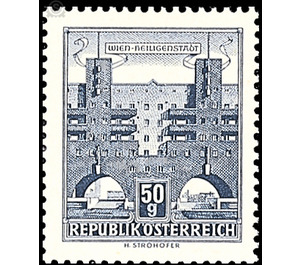Structures - Austria / II. Republic of Austria 1959 - 50 Groschen
Theme: Architecture
| Country | Austria / II. Republic of Austria |
| Issue Date | 1959 |
| Face Value | 50.00 |
| Color | blue |
| Printing Type | offset |
| Stamp Type | Definitive |
| Item Type | Stamp |
| Chronological Issue Number | 387 |
| Chronological Chapter | OOS-OE2 |
| SID | 795215 |
| In 132 Wishlists | |
The brand image shows the striking partial view of Wohnbau Wien-Heiligenstadt in Vienna's 19th district. The poor housing conditions after the end of the First World War also demanded effective initiatives at community level. The municipality of Vienna announced its first social housing program in autumn 1923. Within five years, 25,000 apartments, ie 5,000 apartments a year, were to be created in a completely new way. By 1934, 64,000 so-called folk dwellings were subsequently handed over to the Viennese population. Infrastructural factors, such as traffic conditions, play a key role in a large residential complex. In the period from 1926 to 1930, a landmark of the social housing of the thirties, the Karl-Marx-Hof, was built on a broad meadow, on which commercial gardens were located in the period after the First World War. The total area of the building complex with its gardens and open spaces occupies an area of 156,027 square meters. Only 18.4 percent, not even a quarter of the total area, is installed, while the rest forms yard areas with gardens or playgrounds for children and paths. It created a huge housing estate, which is equivalent to the size of a small town with nearly 5000 inhabitants with almost 1400 apartments.


